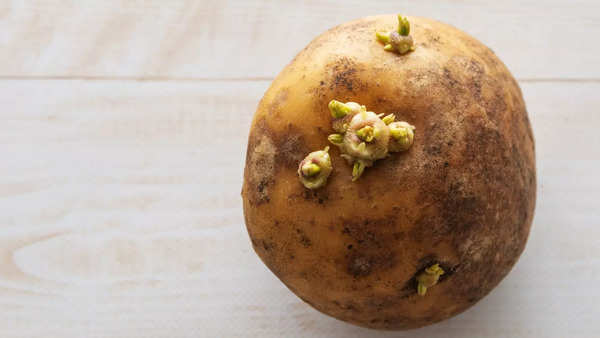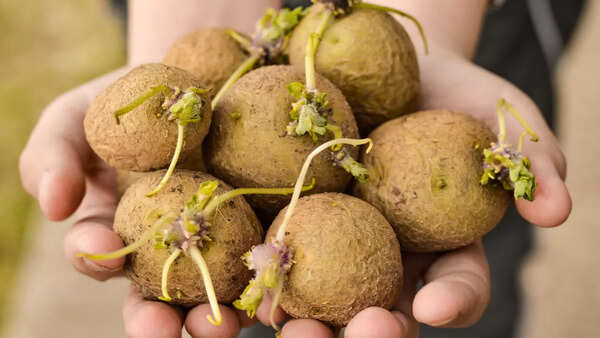Trending
What are sprouted potatoes, and is it safe to consume them
To preserve potato shelf life, remove sprouts, peel, and cook thoroughly. Store in cool, dark places and separate from onions. These practices prevent sprouting, ensuring safe consumption and freshness over time.

Potatoes are one of the most popular staple foods around the world, beloved for their versatility and nutritional value. However, a common question that arises is whether sprouted potatoes are safe to eat. Sprouted potatoes are those that have begun to grow shoots or ‘eyes’, which often happens when they are stored for an extended period. Here’s all you need to know about sprouted potatoes and if they are good for health or not.
ALSO READ: Sprouted Potatoes: Are they safe to cook with?
What causes potatoes to sprout??
Potatoes sprout when they are exposed to light, warmth, and moisture over time. This process is a natural part of their growth cycle. When stored in conditions that favour sprouting, such as in a warm kitchen or under direct light, the dormant buds on the potato begin to grow. The sprouts are essentially new shoots that the potato produces in an attempt to grow into a new plant.

Nutritional changes in sprouted potatoes
While the sprouting process itself is not harmful, it can cause some nutritional changes in the potato. As the potato begins to sprout, it uses its stored nutrients to support the growth of the new shoots. This can lead to a reduction in some of the potato's nutritional value, such as a decrease in its carbohydrate and vitamin C content. However, the most significant concern with sprouted potatoes is the production of certain toxic compounds. Sprouted potatoes can still provide some nutrition, including vitamins C and B6, potassium, and fibre. However, they may also contain higher levels of solanine, a natural toxin that can cause nausea, vomiting, and other health issues if consumed in large quantities. It's best to remove the sprouts and any green parts before cooking, or avoid consuming sprouted potatoes altogether for safety.
ALSO READ: Why onions and potatoes should not be stored together?
The danger of Glycoalkaloids
When potatoes sprout, they produce Glycoalkaloids, which are natural toxins found in the nightshade family of plants. The two primary Glycoalkaloids found in potatoes are solanine and chaconine. These compounds are present in all parts of the potato plant, but their concentrations can increase significantly in sprouted or greened potatoes.
ALSO READ: Can you eat green potatoes? Here's the answer
Glycoalkaloids serve as a natural defence mechanism for the plant, protecting it from pests and diseases. However, in humans, consuming high levels of these toxins can lead to symptoms of glycoalkaloid poisoning, which include nausea, vomiting, diarrhoea, and abdominal pain. In severe cases, it can cause neurological symptoms such as headaches, dizziness, and confusion.
Glycoalkaloids are naturally occurring compounds found in several foods, particularly in the nightshade family. Apart from Sprouted and Green Potatoes, this compound can be found in tomatoes, and eggplants contain significant amounts of glycoalkaloids. While they contribute to the plant's defense mechanisms, high consumption of glycoalkaloids can be toxic to humans, causing symptoms like nausea and digestive disturbances. Cooking can reduce but not eliminate these compounds.
Is it safe to eat sprouted potatoes?
The safety of consuming sprouted potatoes depends on the extent of the sprouting and the presence of any green discolouration. If the sprouts are small and the potato is firm, it is generally safe to eat after removing the sprouts and any green areas. Here's how to ensure the potato is safe to consume:
ALSO READ: 6 tips and tricks to buying and storing potatoes
Remove the sprouts: Use a knife to cut away the sprouts and any green or discoloured parts of the potato. Make sure to remove a good portion of the surrounding area to eliminate any concentrated glycoalkaloids.
Peel the potato: Peeling the potato can help reduce glycoalkaloid levels since these compounds are most concentrated in the skin and just beneath it.
Examine the potato: If the potato is soft, wrinkled, or has an off smell, it is best to discard it, as these are signs of spoilage.
Cook thoroughly: Cooking potatoes thoroughly can help reduce the Glycoalkaloid content, though it does not eliminate it entirely. Boiling, baking, or frying at high temperatures can decrease toxin levels.

How to prevent potato sprouting
To prevent your potatoes from sprouting in the first place, store them in a cool, dark, and dry place. Ideal storage conditions are between 7-10 degrees C. Avoid storing potatoes in the refrigerator, as the cold temperature can convert some of the potato's starches into sugars, leading to an unpleasant taste and increased browning during cooking. Additionally, keep potatoes away from onions, as the gases emitted by onions can accelerate sprouting in potatoes.
Sprouted potatoes are a common occurrence and can be safely consumed if handled correctly. The key is to remove the sprouts and any green or discoloured parts, peel the potato, and cook it thoroughly. By understanding the potential risks and taking appropriate precautions, you can continue to enjoy potatoes as part of a healthy and balanced diet. Always store your potatoes properly to minimize sprouting and ensure they remain fresh and nutritious for as long as possible.
Is sprouted potato good for diabetics?
Sprouted potatoes are not recommended for diabetics or anyone concerned about blood sugar levels. When potatoes sprout, their starch content converts into sugars, increasing their glycemic index. This means sprouted potatoes can cause a quicker spike in blood sugar levels compared to fresh potatoes. Additionally, sprouted potatoes may contain higher levels of solanine, a toxic compound that can cause digestive issues. It's best for diabetics to stick to fresh, properly stored potatoes and monitor portion sizes to better manage blood sugar levels. Another way of using these is by washing and removing the starch.
(Images courtesy: Canva)
ALSO READ: Sprouted Potatoes: Are they safe to cook with?
What causes potatoes to sprout??
Potatoes sprout when they are exposed to light, warmth, and moisture over time. This process is a natural part of their growth cycle. When stored in conditions that favour sprouting, such as in a warm kitchen or under direct light, the dormant buds on the potato begin to grow. The sprouts are essentially new shoots that the potato produces in an attempt to grow into a new plant.

Nutritional changes in sprouted potatoes
While the sprouting process itself is not harmful, it can cause some nutritional changes in the potato. As the potato begins to sprout, it uses its stored nutrients to support the growth of the new shoots. This can lead to a reduction in some of the potato's nutritional value, such as a decrease in its carbohydrate and vitamin C content. However, the most significant concern with sprouted potatoes is the production of certain toxic compounds. Sprouted potatoes can still provide some nutrition, including vitamins C and B6, potassium, and fibre. However, they may also contain higher levels of solanine, a natural toxin that can cause nausea, vomiting, and other health issues if consumed in large quantities. It's best to remove the sprouts and any green parts before cooking, or avoid consuming sprouted potatoes altogether for safety.
ALSO READ: Why onions and potatoes should not be stored together?
The danger of Glycoalkaloids
When potatoes sprout, they produce Glycoalkaloids, which are natural toxins found in the nightshade family of plants. The two primary Glycoalkaloids found in potatoes are solanine and chaconine. These compounds are present in all parts of the potato plant, but their concentrations can increase significantly in sprouted or greened potatoes.
ALSO READ: Can you eat green potatoes? Here's the answer
Glycoalkaloids serve as a natural defence mechanism for the plant, protecting it from pests and diseases. However, in humans, consuming high levels of these toxins can lead to symptoms of glycoalkaloid poisoning, which include nausea, vomiting, diarrhoea, and abdominal pain. In severe cases, it can cause neurological symptoms such as headaches, dizziness, and confusion.
Glycoalkaloids are naturally occurring compounds found in several foods, particularly in the nightshade family. Apart from Sprouted and Green Potatoes, this compound can be found in tomatoes, and eggplants contain significant amounts of glycoalkaloids. While they contribute to the plant's defense mechanisms, high consumption of glycoalkaloids can be toxic to humans, causing symptoms like nausea and digestive disturbances. Cooking can reduce but not eliminate these compounds.
Is it safe to eat sprouted potatoes?
The safety of consuming sprouted potatoes depends on the extent of the sprouting and the presence of any green discolouration. If the sprouts are small and the potato is firm, it is generally safe to eat after removing the sprouts and any green areas. Here's how to ensure the potato is safe to consume:
ALSO READ: 6 tips and tricks to buying and storing potatoes
Remove the sprouts: Use a knife to cut away the sprouts and any green or discoloured parts of the potato. Make sure to remove a good portion of the surrounding area to eliminate any concentrated glycoalkaloids.
Peel the potato: Peeling the potato can help reduce glycoalkaloid levels since these compounds are most concentrated in the skin and just beneath it.
Examine the potato: If the potato is soft, wrinkled, or has an off smell, it is best to discard it, as these are signs of spoilage.
Cook thoroughly: Cooking potatoes thoroughly can help reduce the Glycoalkaloid content, though it does not eliminate it entirely. Boiling, baking, or frying at high temperatures can decrease toxin levels.

How to prevent potato sprouting
To prevent your potatoes from sprouting in the first place, store them in a cool, dark, and dry place. Ideal storage conditions are between 7-10 degrees C. Avoid storing potatoes in the refrigerator, as the cold temperature can convert some of the potato's starches into sugars, leading to an unpleasant taste and increased browning during cooking. Additionally, keep potatoes away from onions, as the gases emitted by onions can accelerate sprouting in potatoes.
Sprouted potatoes are a common occurrence and can be safely consumed if handled correctly. The key is to remove the sprouts and any green or discoloured parts, peel the potato, and cook it thoroughly. By understanding the potential risks and taking appropriate precautions, you can continue to enjoy potatoes as part of a healthy and balanced diet. Always store your potatoes properly to minimize sprouting and ensure they remain fresh and nutritious for as long as possible.
Is sprouted potato good for diabetics?
Sprouted potatoes are not recommended for diabetics or anyone concerned about blood sugar levels. When potatoes sprout, their starch content converts into sugars, increasing their glycemic index. This means sprouted potatoes can cause a quicker spike in blood sugar levels compared to fresh potatoes. Additionally, sprouted potatoes may contain higher levels of solanine, a toxic compound that can cause digestive issues. It's best for diabetics to stick to fresh, properly stored potatoes and monitor portion sizes to better manage blood sugar levels. Another way of using these is by washing and removing the starch.
(Images courtesy: Canva)
End of Article
FOLLOW US ON SOCIAL MEDIA










